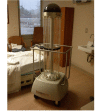Evaluation of an automated ultraviolet radiation device for decontamination of Clostridium difficile and other healthcare-associated pathogens in hospital rooms
- PMID: 20615229
- PMCID: PMC2910020
- DOI: 10.1186/1471-2334-10-197
Evaluation of an automated ultraviolet radiation device for decontamination of Clostridium difficile and other healthcare-associated pathogens in hospital rooms
Abstract
Background: Environmental surfaces play an important role in transmission of healthcare-associated pathogens. There is a need for new disinfection methods that are effective against Clostridium difficile spores, but also safe, rapid, and automated.
Methods: The Tru-D Rapid Room Disinfection device is a mobile, fully-automated room decontamination technology that utilizes ultraviolet-C irradiation to kill pathogens. We examined the efficacy of environmental disinfection using the Tru-D device in the laboratory and in rooms of hospitalized patients. Cultures for C. difficile, methicillin-resistant Staphylococcus aureus (MRSA), and vancomycin-resistant Enterococcus (VRE) were collected from commonly touched surfaces before and after use of Tru-D.
Results: On inoculated surfaces, application of Tru-D at a reflected dose of 22,000 microWs/cm(2) for approximately 45 minutes consistently reduced recovery of C. difficile spores and MRSA by >2-3 log10 colony forming units (CFU)/cm2 and of VRE by >3-4 log10 CFU/cm(2). Similar killing of MRSA and VRE was achieved in approximately 20 minutes at a reflected dose of 12,000 microWs/cm(2), but killing of C. difficile spores was reduced. Disinfection of hospital rooms with Tru-D reduced the frequency of positive MRSA and VRE cultures by 93% and of C. difficile cultures by 80%. After routine hospital cleaning of the rooms of MRSA carriers, 18% of sites under the edges of bedside tables (i.e., a frequently touched site not easily amenable to manual application of disinfectant) were contaminated with MRSA, versus 0% after Tru-D (P < 0.001). The system required <5 minutes to set up and did not require continuous monitoring.
Conclusions: The Tru-D Rapid Room Disinfection device is a novel, automated, and efficient environmental disinfection technology that significantly reduces C. difficile, VRE and MRSA contamination on commonly touched hospital surfaces.
Figures




References
-
- Goodman ER, Platt R, Bass R, Onderdonk AB, Yokoe DS, Huang SS. Impact of an environmental cleaning intervention on the presence of methicillin-resistant Staphylococcus aureus and vancomycin-resistant enterococci on surfaces in intensive care unit rooms. Infect Control Hosp Epidemiol. 2008;29:593–599. doi: 10.1086/588566. - DOI - PMC - PubMed
-
- Eckstein BC, Adams DA, Eckstein EC, Rao A, Sethi AK, Yadavalli GK, Donskey CJ. Reduction of Clostridium difficile and vancomycin-resistant Enterococcus contamination of environmental surfaces after an intervention to improve cleaning methods. BMC Infect Dis. 2007;7:61. doi: 10.1186/1471-2334-7-61. - DOI - PMC - PubMed
Publication types
MeSH terms
LinkOut - more resources
Full Text Sources
Other Literature Sources
Medical
Molecular Biology Databases

